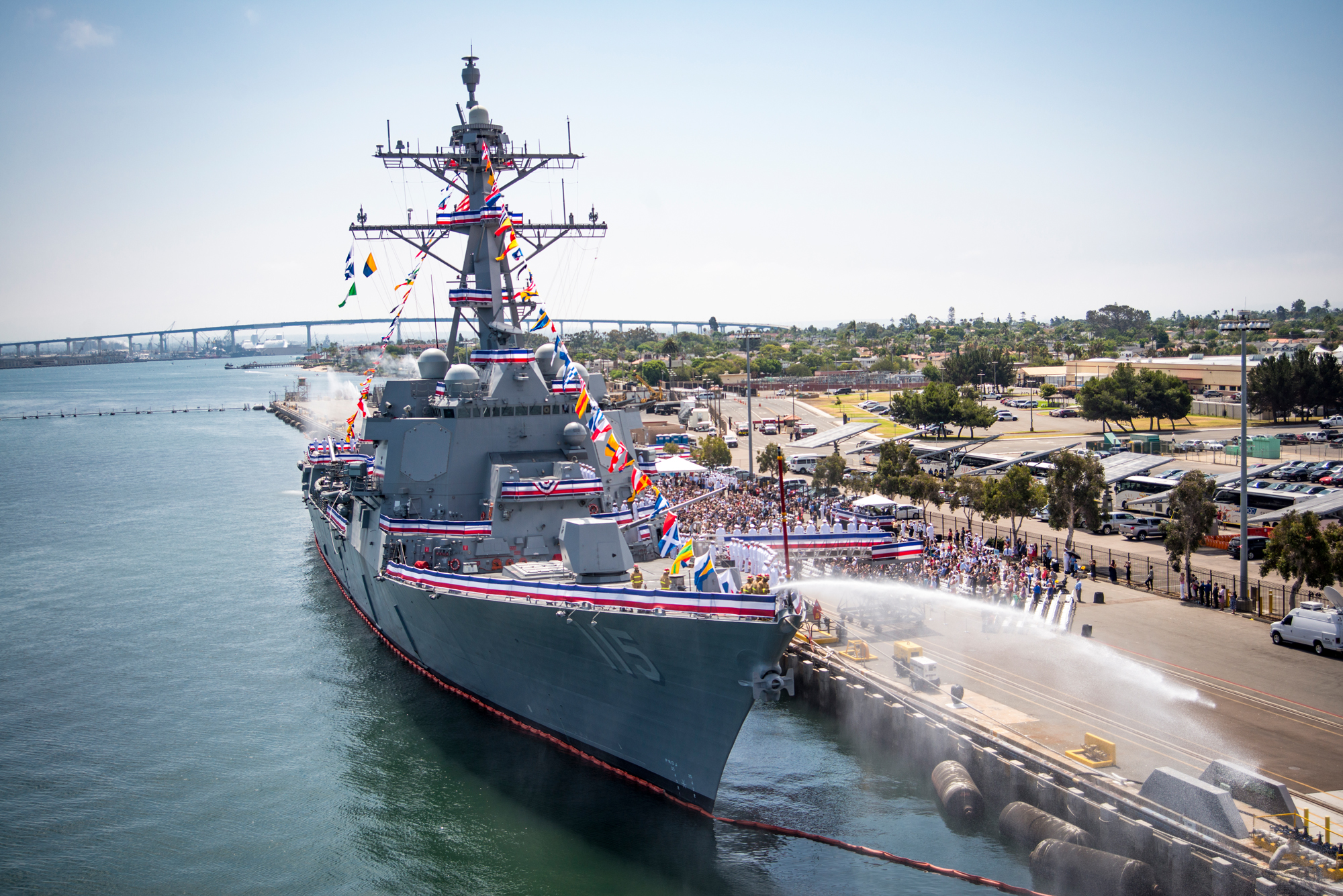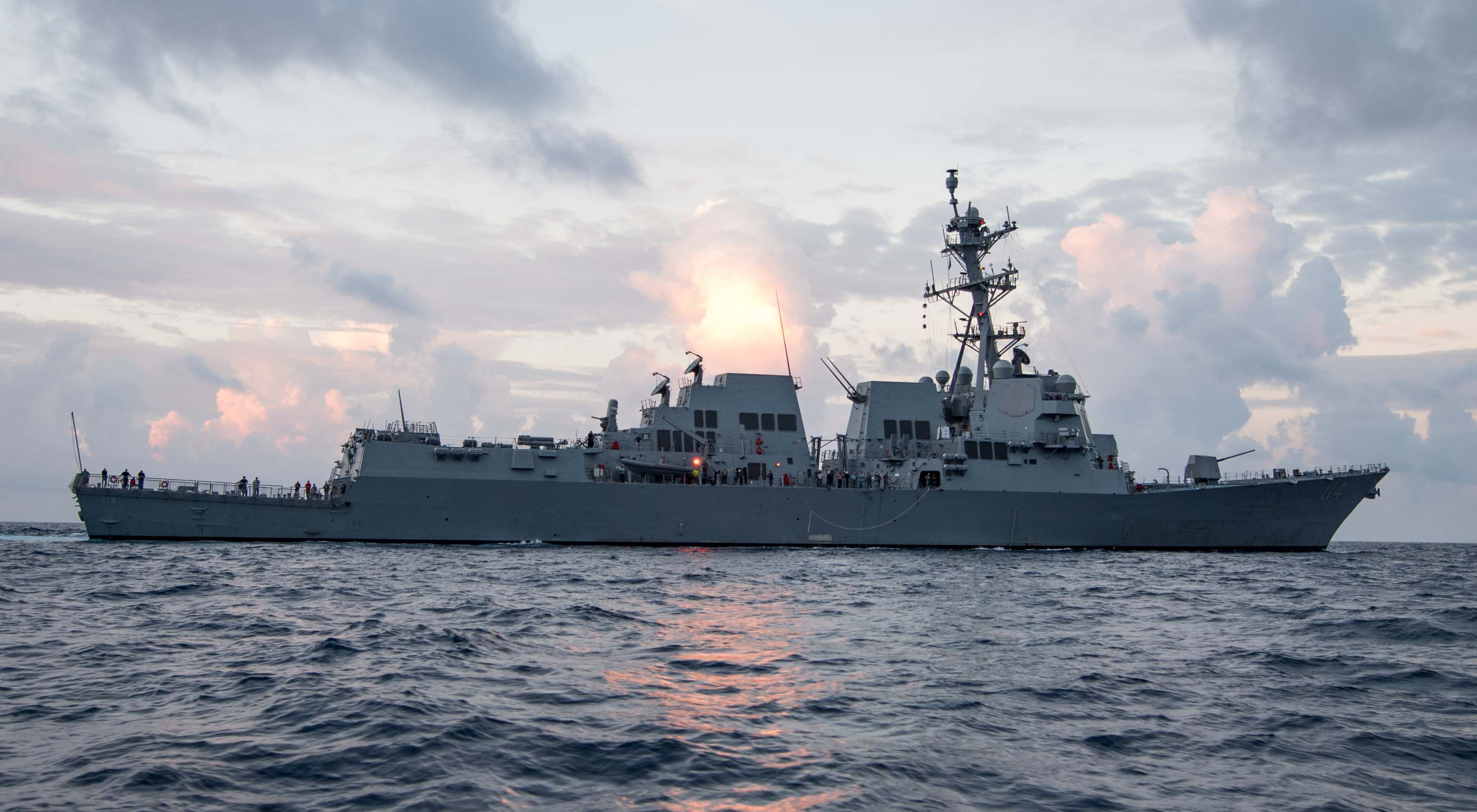
WASHINGTON NAVY YARD – The Arleigh Burke-class destroyer program office has completed 3D modeling of its Flight III design upgrade and will spend 2018 testing major components of the new configuration, the program manager told USNI News.
Capt. Casey Moton said the program office has been working all year on Flight III detail design, with the most critical piece being the 3D modeling of the new design – a process that both builders, Bath Iron Works and Ingalls Shipbuilding, had to undertake separately. Both yards recently completed this process, meeting the long-standing December 2017 goal for this milestone, Moton told USNI News in a Dec. 14 interview.
The Flight III design revolves around the addition of the AN/SPY-6(V) Air and Missile Defense Radar (AMDR), with upgrades to the power and other systems to support the much more powerful radar. About 45 percent of the ship’s drawings zones were affected by the Flight III upgrade, Moton said.
With the 3D modeling complete, the two yards will now go through a “final functional design” effort before fabrication of the Flight III ships can start, to verify that the design changes in the upgrade didn’t unintentionally create any further system-level adjustments that need to be made – additional fire main requirements, for example. Moton said that should wrap up by May, just in time for Ingalls’ planned start of fabrication on its first Flight III hull, DDG-125.
AMDR testing has been going well, Moton said, with all the cooling and power requirements holding steady and no signs that the radar would require any further changes to the ship design. The radar will move to Lockheed Martin’s Aegis Combat System testing facility in Moorestown, N.J., later this fiscal year to be married up with the combat system hardware for integration. Testing will take place in Moorestown, beginning with site activation in Fiscal Year 2019 and spanning several years, Moton said, but is expected to be completed before the radar and combat system have to be installed on the first Flight III ship and prepared for combat system light-off.
As a risk-reduction measure, while the radar itself was testing the transmitting radius in Hawaii, engineers in Moorestown were already working on integrating the back end of the radar system – the electronic cabinets and other components – with Aegis hardware. Some integration issues were identified and are being fixed now, Moton said, noting that identifying those issues as early as possible was the point of this Combat Systems Interface Support Equipment Testing.

The AMDR will also require a new electrical plant for the ship, which Moton said is also performing well in testing. A power conditioning module, which converts the new generators’ 4,160-volt AC power into 1,000-volt DC power, is “nearing completion of testing” with builder Leonardo DRS and should ship to the Land-Based Engineering Site in Philadelphia next month for further testing. The 4,160-volt generators, which were developed for the DDG-1000 program, should also ship to the Philly test site next month. As the remaining power system equipment arrives there early in 2018, the power system will be able to light off in FY 2019.
“The Flight III technical piece is proceeding on schedule, and we haven’t had any major issues,” Moton said.
“Doesn’t mean we haven’t had any issues, but we haven’t had any major issues. Obviously the big piece, a huge step in risk reduction will be when we first light everything off in Moorestown and when we first light everything off in Philadelphia.”
Moton acknowledged the importance of those two light-off dates, but he said he is already comfortable with the maturity of the Flight III design and the progress in developing and testing the radar and electrical plant. Much has been made of the maturity of the design – both because risk was a major factor in contract negotiations with both yards as the Navy looked to insert the Flight III design into an existing multiyear procurement contract, and because lawmakers on the Hill worried that the mid-contract upgrade wouldn’t allow them sufficient oversight opportunities – but Moton said previous milestones have assured him that the program office is on a path to success with this capability upgrade.
“I don’t want to somehow take away from the fact that when we light everything off at Moorestown and Philadelphia, that’s going to be a big deal for us to get through that,” Moton told USNI News.
“But from an individual component level, when the Navy submitted its [President’s Budget 2018] request, or shortly after that, we submitted a multiyear request for Fiscal 18 to 22, and part of the multiyear request was the Navy certifying a stable design. That had oversight at the [assistant secretary of the Navy for research, development and acquisition] level and at the [under secretary of defense for acquisition, technology and logistics] level. We’ve got to sometimes keep in perspective that on a new ship class … typically detail design doesn’t start until after you’ve awarded a contract to a shipbuilder. So we were already sort of well ahead of that game on Flight III.”
Asked when he could confidently say the risk in the upgrade has been managed, Moton replied, “we think that we’re already there.”

As the detail design and the component testing progressed throughout 2017, so did contract negotiations with Bath Iron Works and Ingalls Shipbuilding for the mid-contract Flight III upgrade. The Navy issued its request for proposals in May 2016, and negotiations lasted more than a year – Ingalls signed a contract in June 2017 and Bath in October 2017.
“If you look at those timelines, you probably know it was a robust discussion. But we were able to get the Flight IIIs awarded within our budget,” Moton said.
“We had a lot of discussions with both shipbuilders about risk-sharing on the contract. The Navy wanted to do a fixed-price contract – now, fixed-price doesn’t mean firm fixed-price; fixed-price incentive, on a shareline, government shares the risk and the contractor shares the risk. It’s probably not much of a secret that there were pretty healthy discussions with both shipbuilders about what that risk-sharing should be, so it took a while.”
Moton noted that Ingalls’ start of fabrication date of May 2018 hasn’t changed despite the lengthy contract negotiations, in part because the Navy provided the shipyard long lead time material and long lead time engineering funding to keep DDG-125 on track.
Talks with Bath Iron Works had the added complication of a second ship – whereas the Navy only wanted Ingalls to change its one FY 2017 ship to the Flight III design, Bath had both a 2017 ship and an additional hull Congress incrementally funded in 2016 and 2017. Ultimately BIW and the Navy agreed to keep that incrementally funded ship in the older Flight IIA configuration.
So, DDGs 125 and 126 will be Flight III, 127 will be a Flight IIA ship, and then 128 and beyond will fall in the next multiyear contract that will be all Flight III ships.
“In the end, we reached a pretty good deal with Bath in the sense that the extra Flight IIA ship gives them one more ship to make sure their workload is stabilized as they start to tail off DDG-1000 construction,” Moton said.
“And it also frankly worked to give them some additional time before they start cutting steel on Flight III, so in the end it worked out, it worked out well.”
Overall, Moton said he’s pleased to have both yards on contract for Flight III construction ahead of negotiations for the next multiyear procurement contract.
“I’d like to think we did a good job working together with both yards to get both sides comfortable with the risk, and the bottom line is we were able to reach an agreement with both shipbuilders for Flight III and contractually on how to handle that risk,” Moton said.
“It’s a big change, but the desire to do that was driven by the operational need. … World events were driving the desire to get this radar out there as quickly as possible. I don’t need to name what those world events are.”





